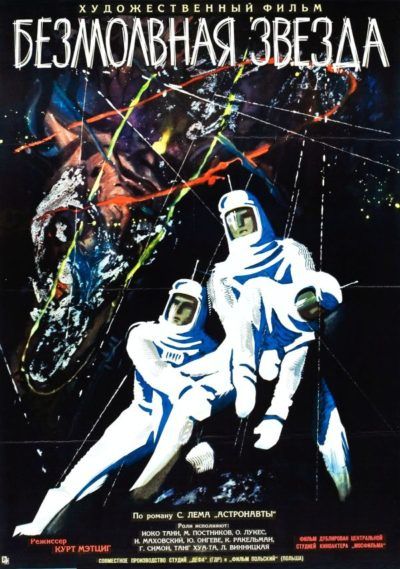
Rating: C+
Dir: Kurt Maetzig
Star: Mikhail Postnikov, Oldřich Lukeš, Günther Simon, Yoko Tani
a.k.a. First Spaceship on Venus
An alien artifact is found in the Gobi Desert and after an international research effort, turns out to be evidence of an intelligently controlled craft from Venus, which exploded over Siberia in 1908. When attempts to communicate with the planet go unanswered, a multi-national group of astronauts are sent to explore the planet, on the Soviet craft Kosmoskrator. Under the command of American, Professor Hawling (Lukeš), they include German pilot Brinkmann (Simon), unfortunately named Russian cosmonaut Professor Arsenjew (Postnikov) and Japanese medical officer Dr. Ogimura (Tani). However, on the journey, further decoding of the artifact uncovers a plan by the Venusians to wipe Earth clean of life, in preparation for a very hostile takeover.
The original cut was edited down by 14 minutes for the US release as First Spaceship on Venus, which was then the topic of an MST3K episode. It’s certainly the case that they’ve used far worse movies. From a purely technical point of view, this does better in depicting space and spaceships than many equivalent movies this side of the Iron Curtain. It helps the movie’s design looks super-sleek, such as the Kosmoskrator (top). Considering the film was made before any human had gone into space, there are elements where it’s almost eerily predictive. For example, there’s an intelligent robot, Omega, which responds to verbal questions in a way rather like Alexa or Siri. As this illustrates, the film is definitely “hard science fiction”, more interested in nuts and bolts than the human elements and relationships.
 There is one exception, with Hawling having previously had a thing with Ogimura, which occasionally sputters back into life. Fortunately, it’s only a 31-day journey to Venus, or the 7:1 gender ratio could have become a bit problematic. It’s also worth noting the presence of a black astronaut, something which would take another 20 years to pass in reality. Of course, the science is wildly off the mark in terms of the surface of Venus, which is utterly inhospitable – we’re talking 450 degrees C, ninety times Earth pressure and sulphuric acid rain. Based on a 1951 book by Polish author by Stanisław Lem, I imagine he simply didn’t know any better at the time.
There is one exception, with Hawling having previously had a thing with Ogimura, which occasionally sputters back into life. Fortunately, it’s only a 31-day journey to Venus, or the 7:1 gender ratio could have become a bit problematic. It’s also worth noting the presence of a black astronaut, something which would take another 20 years to pass in reality. Of course, the science is wildly off the mark in terms of the surface of Venus, which is utterly inhospitable – we’re talking 450 degrees C, ninety times Earth pressure and sulphuric acid rain. Based on a 1951 book by Polish author by Stanisław Lem, I imagine he simply didn’t know any better at the time.
The story offers an interesting twist, because the Venusian threat is now operating on auto-pilot, an apocalyptic disaster having befallen the planet’s civilization. However, this lack of any actual antagonist probably works against the movie as a whole. It leaves the audience with a lot of scenes of planetary exploration of the devastated surface, accompanied by gloomy pronouncements, comparing the situation to Hiroshima for example (they left their shadows burned onto the walls), or scientific chit-chat. The direct peril is limited to things like meteors, or Ogimura getting slightly stuck in moderately slow-moving mud. Not especially pulse-pounding stuff. The Cold War style is undeniably what makes this worth a watch, depicting a view of the future that is considerably cooler than the one we actually get to inhabit.
